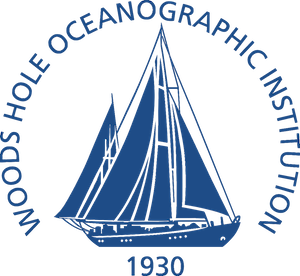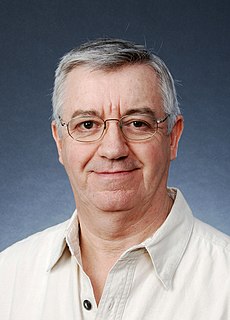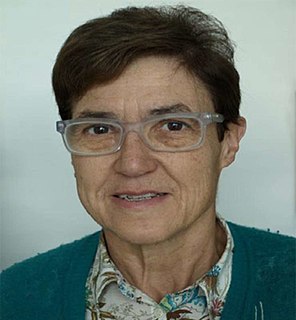Related Research Articles

An algal bloom or algae bloom is a rapid increase or accumulation in the population of algae in freshwater or marine water systems. It is often recognized by the discoloration in the water from the algae's pigments. The term algae encompasses many types of aquatic photosynthetic organisms, both macroscopic multicellular organisms like seaweed and microscopic unicellular organisms like cyanobacteria. Algal bloom commonly refers to the rapid growth of microscopic unicellular algae, not macroscopic algae. An example of a macroscopic algal bloom is a kelp forest.

The Woods Hole Oceanographic Institution is a private, nonprofit research and higher education facility dedicated to the study of marine science and engineering.

Colored dissolved organic matter (CDOM) is the optically measurable component of dissolved organic matter in water. Also known as chromophoric dissolved organic matter, yellow substance, and gelbstoff, CDOM occurs naturally in aquatic environments and is a complex mixture of many hundreds to thousands of individual, unique organic matter molecules, which are primarily leached from decaying detritus and organic matter. CDOM most strongly absorbs short wavelength light ranging from blue to ultraviolet, whereas pure water absorbs longer wavelength red light. Therefore, water with little or no CDOM, such as the open ocean, appears blue. Waters containing high amounts of CDOM can range from brown, as in many rivers, to yellow and yellow-brown in coastal waters. In general, CDOM concentrations are much higher in fresh waters and estuaries than in the open ocean, though concentrations are highly variable, as is the estimated contribution of CDOM to the total dissolved organic matter pool.

Ocean color is the branch of ocean optics that specifically studies the color of the water and information that can be gained from looking at variations in color. The color of the ocean, while mainly blue, actually varies from blue to green or even yellow, brown or red in some cases. This field of study developed alongside water remote sensing, so it is focused mainly on how color is measured by instruments.

Alexandra (Alex) Z. Worden is a microbial ecologist and genome scientist known for her expertise in the ecology and evolution of ocean microbes and their influence on global biogeochemical cycles.
Helen Amanda Fricker is a glaciologist and professor at Scripps Institution of Oceanography at the University of California, San Diego where she is a director of the Scripps Polar Center. She won the 2010 Martha T. Muse Prize for Science and Policy in Antarctica.
Susana Agustí Requena is a Spanish biological oceanographer who has participated in over 25 oceanographic expeditions in the Arctic, Southern Ocean (Antarctic), Atlantic, Pacific and Indian Oceans. She played a key role in the Malaspina Circumnavigation Expedition. She is professor in Marine Science at King Abdullah University of Science and Technology in Saudi Arabia and an adjunct Professor at the University of Tromsø (Norway).

Plankton, Aerosol, Cloud, ocean Ecosystem (PACE) is a NASA Earth-observing satellite mission that will continue and advance observations of global ocean color, biogeochemistry, and ecology, as well as the carbon cycle, aerosols and clouds. PACE will be used to identify the extent and duration of phytoplankton blooms and improve understanding of air quality. These and other uses of PACE data will benefit the economy and society, especially sectors that rely on water quality, fisheries and food security.

Trevor Charles Platt was a British and Canadian biological oceanographer who was distinguished for his fundamental contributions to quantifying primary production by phytoplankton at various scales of space and time in the ocean.
Angelicque E. White is an American oceanographer. She is an associate professor at the University of Hawaiʻi at Mānoa School of Ocean and Earth Science and Technology and director of the Hawaii Ocean Time-series (HOT) program.

Marta Estrada Miyares is a Catalan researcher, with a career in oceanography and marine biology. Her most prominent studies are based on the physiological characterization and ecological impact of algae and phytoplankton.
Paula Susan Bontempi is an oceanographer who has led the use of satellites in marine science during her positions in NASA and as the dean of the Graduate School of Oceanography at the University of Rhode Island.
Mary Wilcox Silver is Professor Emerita at the University of California Santa Cruz. Silver is known for research on marine snow and harmful algal blooms, setting the stage for woman conducting research in the field, and for mentoring and teaching of graduate and undergraduate students.
Mary Jane Perry is an American oceanographer known for the use of optics to study marine phytoplankton.

Ocean optics is the study of how light interacts with water and the materials in water. Although research often focuses on the sea, the field broadly includes rivers, lakes, inland waters, coastal waters, and large ocean basins. How light acts in water is critical to how ecosystems function underwater. Knowledge of ocean optics is needed in aquatic remote sensing research in order to understand what information can be extracted from the color of the water as it appears from satellite sensors in space. The color of the water as seen by satellites is known as ocean color. While ocean color is a key theme of ocean optics, optics is a broader term that also includes the development of underwater sensors using optical methods to study much more than just color, including ocean chemistry, particle size, imaging of microscopic plants and animals, and more.

The SeaWiFS Bio-optical Archive and Storage System (SeaBASS) is a data archive of in situ oceanographic data used to support satellite remote sensing research of ocean color. SeaBASS is used for developing algorithms for satellite-derived variables and for validating or “ground-truthing” satellite-derived data products. The acronym begins with “S” for SeaWiFS, because the data repository began in the 1990s around the time of the launch of the SeaWiFS satellite sensor, and the same data archive has been used ever since. Oceanography projects funded by the NASA Earth Science program are required to upload data collected on research campaigns to the SeaBASS data repository to increase the volume of open-access data available to the public. As of 2021 the data archive contained information from thousands of field campaigns uploaded by over 100 principal investigators.
Patricia Marguerite Glibert is marine scientist known for her research on nutrient use by phytoplankton and harmful algal blooms in Chesapeake Bay. She is an elected fellow of the American Association for the Advancement of Science.
Colleen Beckmann Mouw is an associate professor at the University of Rhode Island known for her work on phytoplankton ecology and increasing retention of women in oceanography.
Evelyn Lessard is a biological oceanographer and a professor at the University of Washington's School of Oceanography.
Nils Gunnar Jerlov (1909–1990) was a Swedish oceanographer, physicist, scientist, and researcher who studied how light interacts with water. He was a pioneering scientist in the field of ocean optics, and his water types are used to define the color and characteristics of natural water bodies.
References
- ↑ "Oceanography Tree - Mary Jane Perry". academictree.org. Retrieved 2021-06-02.
- 1 2 "Collin Roesler | Bowdoin College". www.bowdoin.edu. Retrieved 2019-11-12.
- 1 2 3 4 "PACE-ing herself: Collin Roesler explores the deep sea". The Bowdoin Orient. 2019-10-04. Retrieved 2019-11-12.
- ↑ Goldfine, Rebecca. "Five Faculty Promoted to Full Professor | Bowdoin News Archive" . Retrieved 2019-11-12.
- ↑ College, Bowdoin (2016-08-15), The lab of Collin Roesler, professor of earth and oceanographic science , retrieved 2019-11-12
- ↑ "Luke Carberry '18 and Professor Collin Roesler Publish Breakthrough Oceanography Finding | Bowdoin College". www.bowdoin.edu. Retrieved 2019-11-12.
- ↑ "Mystery of green icebergs may soon be solved". AGU Newsroom. Retrieved 2019-11-12.
- ↑ Bowdoin. "Fathoming the Science Behind Paralytic Shellfish Poisoning #tbt | Bowdoin News Archive" . Retrieved 2019-11-12.
- 1 2 CBC Radio (2019). "Mysterious green icebergs from Antarctica might be fertilizing the southern ocean". CBC. Archived from the original on 2019-07-26.
- ↑ "Scientists Might Finally Know Why Some Icebergs Are Bright Green". Earther. Retrieved 2019-11-12.
- ↑ "Mystery of green icebergs may soon be solved". UW News. Retrieved 2019-11-12.
- ↑ Hester, Jessica Leigh (2019-03-11). "Icebergs Can Be Surprisingly Colorful". Atlas Obscura. Retrieved 2019-11-12.
- ↑ Grossman, David (2019-03-07). "The Curious Reason Some Icebergs Are Green". Popular Mechanics. Retrieved 2019-11-12.
- ↑ Armstrong, Rosemary. "Woods Hole Oceanographic Institution and Bowdoin collaborate to monitor 'red tide' phytoplankton | Bowdoin News Archive" . Retrieved 2019-11-12.
- ↑ "Collin Roesler". PACE. Retrieved 2019-11-12.
{{cite web}}: CS1 maint: url-status (link) - ↑ "Small Steps, Giant Leaps: Ocean-Atmosphere Understanding". pace.oceansciences.org. Archived from the original on 2020-09-27. Retrieved 2019-11-12.
- ↑ "Ocean Optics Web Book • A collaborative web-based book on optical oceanography". www.oceanopticsbook.info. Retrieved 2019-11-12.
- ↑ "The Interplay of Science and Art: Field Note Friday in the Museum | Bowdoin College". www.bowdoin.edu. Retrieved 2019-11-12.